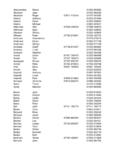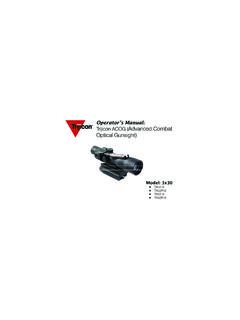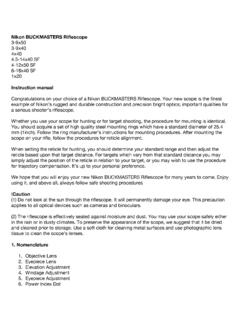Transcription of TAKING AIM – LINE & LENGTH - Chesterton Indoor Bowls
1 TAKING AIM LINE & LENGTH by Rob Judson December 2002 TAKING Aim Line & LENGTH Page 2 Line and LENGTH aiming Line General Objectives The aiming line is the required delivery direction. If Bowls are to come to rest in the head, bowlers must deliver them at an angle that counteracts the effect of bias. Because Bowls delivered along the same line but at different speeds all finish in a straight line, bowlers should not change the aiming angle for a change in head distance. However, an angular shift of the usual aiming line becomes necessary to correspond with any sideways movement of the jack, or with an off-centre object position in the head.
2 Some bowlers have a fixation on the jack. They tend to bowl 'at' the jack rather than 'to' it. Some bowlers tend not to trust the bias of their Bowls . Both groups repeatedly use aiming lines that are too 'narrow'. Their Bowls commonly cross the centre line before reaching the head, or displace critical Bowls in the head. Narrow Bowls are attacking Bowls , and bowlers should not attack heads that lie in their favour. In the course of a game, bowlers should correct any tendency towards narrow deliveries by widening their aiming angle, and should correct wide deliveries by narrowing it. Bowlers should focus along the aiming line to avoid narrow bowling. Landmarks as aiming References Bowlers have several options for selecting aiming line.
3 Some of them use patterns or marks on the mat to consistently position and align their dominant foot in the intended delivery direction. Their aiming line is approximately the forward extension of their anchor foot alignment. An advantage of this method is that changes in mat position relative to the ditch do not affect their aiming angle. If the object position in the head is off centre, they determine the required angular adjustment and correspondingly change foot alignment relative to patterns or marks on the mat. They use the mat like a protractor with a radius of a shoe LENGTH (about 30 cm). A drawback to the method is that a mere 1 error in aiming angle results in a sideways error of about m at the head.
4 Some bowlers use rink markers, or boundary pegs, or other reference points on or beyond the bank that correspond with the required initial direction for the visualised path of their Bowls . The imaginary line from the selected reference point back to the mat is their aiming line. They tend to visualise the entire green as a large protractor. An associated disadvantage is that different mat positions relative to the ditch necessitate adjusted reference points. Forehand and backhand deliveries obviously have different reference points. Reversal of direction of play for each successive end also necessitates different aiming reference points. Some bowlers are so familiar with the way their Bowls turn according to the pace of green that they use intuitive skill to select a suitable aiming line.
5 Some bowlers simply observe the amount that Bowls of other players are turning, particularly during trial ends. They begin a game by allowing for a similar amount of turn, and adjusting the aiming line, if necessary, for their subsequent deliveries. Other bowlers use combinations of these methods. aiming Line and Delivery Line An aiming line is the line of sight. It is the line between the sighting eye and the chosen aiming point. The delivery line is the line that the bowl initially travels upon release. It is the line followed by the bowling hand near the bottom of the forward swing of the delivery arm. The back-foot line is the alignment of the foot that remains in contact with the mat at the instant of bowl release.
6 In an upright posture, with feet together, before commencement of the delivery movement, a bowler s aiming line tends to coincide with the foot line. The sighting eye tends to be directly above the instep of the back foot. At the same time, if the bowl is held near the hip, the delivery line (in the unlikely event of its being released from that position) is wide of both the aiming and back-foot lines. As a bowler executes the delivery movement, the head tends to incline towards the shoulder of the delivery arm. This inclination tends to move the aiming line outward. The trunk also tends to incline towards the shoulder of the delivery arm. This inclination has the effect of moving the hip out of the way of the delivery arm, and tends to allow the delivery line to move inward.
7 The typical outward movement of the aiming line coupled with inward movement of the delivery line tends to bring them into coincidence on reaching the release posture. TAKING Aim Line & LENGTH Page 3 Observations and measurements of many bowlers show that, although there are significant individual differences, any horizontal separation between aiming line and delivery line averages less than 3 cm. Bowlers intuitively accommodate any small difference without any conscious adjustment. Thus, the aiming line tends to move away from the foot line in the course of a delivery movement. Observations and measurements show that the horizontal separation between the foot line and the wider, aiming /delivery line averages 12 cm at the instant of release.
8 This is equivalent to the diameter of a bowl. Separations of up to 20 cm are not rare. In delivering biased Bowls , bowlers accommodate any difference between the foot line and the aiming /delivery line by intuitively adopting a marginally narrower aiming point on the forehand side and a marginally wider aiming point on the backhand side. In delivering jacks, many lead players simply adopt a line that converges on a point approximately where the jack should come to rest. Where chalked segments of the rink centre line are visible, some lead players like to use them as a track for the jack. To facilitate this intention, some bowlers advocate the planting of the anchor foot on, and aligned with the centre line.
9 That alignment suits bowlers whose delivery line matches their extended back foot line. Other bowlers advocate placement of the anchor foot inside the centre line to the extent that the entire shoe might be clear of it. That alignment suits (arguably the greater number of) bowlers whose delivery line is wide of their back foot line. The amount of anchor (back) foot offset should match the delivery line offset of the individual bowler, rather than reflect any dogma that either option is universally superior. aiming Point A point on the aiming line on which a bowler focuses attention for bowl delivery is the aiming point. Sometimes slight irregularities in texture or colour of the grass provide visible aiming marks on the aiming line.
10 Indoor playing surfaces tend not to have such irregularities. Beginners sometimes benefit from temporary use of aids such as small discs or cotton wool tufts on the green, until they are able to select aiming lines without them. Some bowlers choose an aiming point within a few metres of the mat. The initial path of a bowl has negligible curvature. They deliver their Bowls so that they travel over the aiming point. This method particularly suits bowlers who have a stooped stance, which could be the result of positioning the back knee nearer to the calf than the heel of the front If the spine were nearly level, sighting with a more distant aiming point would cause too much neck discomfort for most bowlers.







